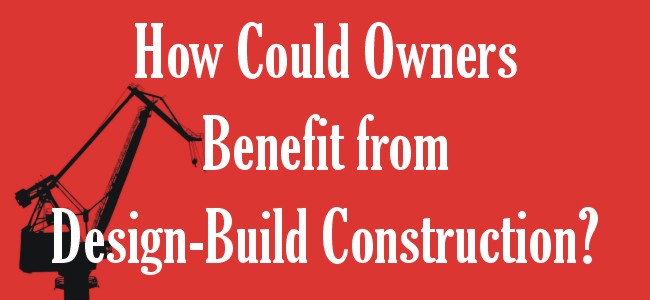How Could Owners Benefit from Design-Build Construction?
 There are several perceived advantages to using design-build. In this Ideas & Insights, I want to look at those potential advantages from the perspective of the owner. Even if you are a contractor, I think it’s important, when discussing design-build, to consider the owner’s perspective.
There are several perceived advantages to using design-build. In this Ideas & Insights, I want to look at those potential advantages from the perspective of the owner. Even if you are a contractor, I think it’s important, when discussing design-build, to consider the owner’s perspective.
Single Point of Responsibility
One of the most basic advantages is that the owner enjoys a single point of responsibility for both design and construction. Ultimately, this could limit the owner’s exposure to errors and omissions. That design-build team is responsible for both the design and the construction. If there are any errors or omissions in that design, it becomes the responsibility of the design-build entity. The owner would often stand between the designer and the contractor in the design-bid-build approach.
Accelerated Delivery
You can get accelerated project delivery results. One of the reasons for this is you can “fast track” the design and construction (meaning you can design at the same time you are constructing the facility). This is of course phased or staged. For example, the design of the foundations precedes the design of the building superstructure; which precedes the design of the guts of the building. Once the design for the foundations is completed, it can go out to bid and construction of the foundations can begin before the design of the superstructure or the guts of the building is completed. This is possible in the design-build process because the designer and the contractor are one entity. In the traditional design-bid-build process, there is usually a need for the entire design to be completed so the contractor can submit a price for the entire project.
Less Coordination Burden
Design-build also relieves the owner of a substantial amount of the coordination burden from one phase to the next. Some of the worst disputes I have ever been involved with were design-bid-build projects where the design was fast tracked and construction was phased according to the design. That’s not to say it can’t be a successful approach. I just think some of us have discovered doing it with the design-build method is much more effective.
There is also the perception that design-build can result in much closer coordination between the designer and the constructor. Sometimes I think that is true. But other times, I don’t. It depends a little bit upon the relationship and how well the designer and constructor work together. I have been involved with design-build projects where I didn’t see much evidence of coordination at all.
Constructability, Quality, and Cost
Some also say the design-build process results in a more constructible and, thus, ultimately less expensive facility. In my experience, the process does yield a more constructible facility. It may or may not be less expensive. It also allows for the project price and schedule to be determined earlier, sometimes before the design is even started. With design-build, you have given the contractor much more flexibility in terms of the execution of the project. You might have even awarded the project on the basis of innovations, function, or performance of the facility. When you’ve incentivized the contractor to focus on these kinds of things, that may increase the chances they can offer you a project at the lowest possible cost (and the greatest or best performance characteristics). You can also delegate the quality assurance and control responsibilities associated with executing the project.
Design Alternatives
There certainly will be an ability to consider a more alternative design, since you have a full team in place. The designer will be in a position to identify the most important design considerations. The contractor will be in a position to quickly price those alternatives. There can also be quite a bit of flexibility in terms of materials and construction methods when working with a design-build team.
Ultimately, yes, there are some strong potential upsides of using design-build. But as I have alluded to, and as we will discuss in future Ideas & Insights, there are potential pitfalls.
Scott Lowe is a Principal of TRAUNER and is an expert in the areas of critical path method scheduling, construction claim preparation and evaluation, and specification writing. He can be reached at scott.lowe@traunerconsulting.com.
If you liked this article, be sure to sign up on the left side of our website to receive our Ideas & Insights in your email. Be sure to check your email after signing up!

